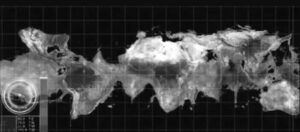If the speed around the Sun and Earth’s rotation were equal, our planet would be tidally locked. This means that one side of the planet will always face the Sun and the other side will be shrouded in permanent darkness.
In the eyes of us Earthlings, the Moon is the easiest celestial body to observe in the night sky. If you look closely at the Moon, you will see that no matter what time it is, the Moon’s surface does not change, and This means that it always faces the Earth in the same direction.
In fact, this phenomenon is not mysterious, the reason is because the Moon is tidally locked by the Earth, so the rotation period around the Earth is exactly the same as its rotation period.
Similarly, if the Earth is tidally locked by the Sun, one side of the Earth will always face the Sun, this way, one side of the Earth will always be daytime and one side will always be dark.
So the question is, in this case, what will happen to the Earth? In fact, researchers used computer models to simulate this situation.
It should be noted that for convenience of description, we can call the part of the Earth that is “always daytime” the “day hemisphere”, and the remaining part can be called the “night hemisphere”.
Because the “day hemisphere” is always exposed to sunlight, its surface temperature will be higher, while the situation in the “night hemisphere” is the opposite, so the “day hemisphere” and “night hemisphere” ” there will be a significant temperature difference. However, because Earth’s atmosphere can exchange heat, this difference is not as large as on other planets.
The simulation results show that the average temperature of the “day hemisphere” is about 40 degrees Celsius, which can be said to be very hot, while the average temperature of the “night hemisphere” is about minus 40 degrees Celsius, so the will freeze, and only the area at the intersection of the “day hemisphere” and “night hemisphere” will have temperatures suitable for human survival.
However, this area is very narrow, the average width is only about 60 km, and because in this area, hot air from the “day hemisphere” and cold air from the “night hemisphere” will compete fiercely, So here there will be strong convective weather that lasts indefinitely, basically there will be storms and intense thunder at any time…

On the other hand, the distribution of Earth’s land and sea will also have major changes. The Earth is not a perfect sphere, its equatorial radius is about 6,378 km, its polar radius is about 6,357 km. There is a gap of about 21 km distance.
That is, in general, the area near the Earth’s equator has a certain degree of bulge. Logically speaking, sea water on the Earth’s surface should have flowed to areas with higher latitudes because of the difference. height. But the truth is that near the Earth’s equator there is actually a large ocean created by “centrifugal force”.
According to the tidal locking principle, if one side of the Earth is always daytime and the other side is always dark, it means that the Earth’s rotation period around the Sun is equal to its rotation period, and at such a low rotation speed. , the “centrifugal force” created is so small that it can essentially be ignored.
In this case, sea water in low-latitude areas of the Earth will flow into high-latitude areas and submerge large areas of land. This area is basically all land. These landmasses are interconnected, forming a high-altitude ring structure on the Earth’s surface, which then divides the Earth’s oceans into two large areas as a whole.

In addition, the air in the Earth’s atmosphere will also have the same phenomenon as sea water, will also flow to low latitudes in large quantities, on that basis, plus the height of the mainland, the air in these areas will This land will become very diluted.
Worse still, the creation of the Earth’s magnetic field is closely related to the Earth’s rotation speed. If the Earth only completed its rotation once per year, the Earth would lose its strong magnetic field. Without the protection of a strong magnetic field, Earth’s natural environment would deteriorate.
In short, it can be seen that if one side of the Earth is always daytime and the other side is always dark, the natural environment on Earth will become extremely bad, causing many existing species on Earth to die. become extinct, and even we humans may not be able to survive.
Fortunately, this is just a hypothetical situation that will not happen, because in reality, the Sun does not tidally lock the Earth.
Although the Sun’s gravity does slow down the Earth’s rotation, this effect is very weak. According to scientists’ estimates, it will take at least 50 billion years for the Sun to lock the Earth’s tides. .

However, in about 5 billion years, the Sun will expand into a giant star, at which point its diameter will expand more than 200 times its current diameter, causing its surface to reach or even exceed beyond Earth’s orbit, meaning, then, the Earth will be swallowed by this red giant star.

